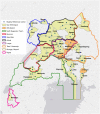East Africa International Center of Excellence for Malaria Research: Impact on Malaria Policy in Uganda
- PMID: 36228904
- PMCID: PMC9662221
- DOI: 10.4269/ajtmh.21-1305
East Africa International Center of Excellence for Malaria Research: Impact on Malaria Policy in Uganda
Abstract
Malaria is the leading cause of disease burden in sub-Saharan Africa. In 2010, the East Africa International Center of Excellence for Malaria Research, also known as the Program for Resistance, Immunology, Surveillance, and Modeling of Malaria (PRISM), was established to provide a comprehensive approach to malaria surveillance in Uganda. We instituted cohort studies and a robust malaria and entomological surveillance network at selected public health facilities that have provided a platform for monitoring trends in malaria morbidity and mortality, tracking the impact of malaria control interventions (indoor residual spraying of insecticide [IRS], use of long-lasting insecticidal nets [LLINs], and case management with artemisinin-based combination therapies [ACTs]), as well as monitoring of antimalarial drug and insecticide resistance. PRISM studies have informed Uganda's malaria treatment policies, guided selection of LLINs for national distribution campaigns, and revealed widespread pyrethroid resistance, which led to changes in insecticides delivered through IRS. Our continuous engagement and interaction with policy makers at the Ugandan Ministry of Health have enabled PRISM to share evidence, best practices, and lessons learned with key malaria stakeholders, participate in malaria control program reviews, and contribute to malaria policy and national guidelines. Here, we present an overview of interactions between PRISM team members and Ugandan policy makers to demonstrate how PRISM's research has influenced malaria policy and control in Uganda.
Figures
References
-
- WHO , 2020. World Malaria Report 2021. Geneva, Switzerland: World Health Organization.
-
- Ministry of Health Republic of Uganda , 2021. Annual Health Sector Performance Report: Financial Year 2020/21.
-
- Ministry of Health Republic of Uganda , 2020. Uganda Malaria Indicator Survey 2018–19. Ministry of Health Kampala Uganda. Available at: https://dhsprogram.com/pubs/pdf/MIS34/MIS34.pdf. Accessed May 10, 2021.
Publication types
MeSH terms
Substances
Grants and funding
LinkOut - more resources
Full Text Sources
Medical


